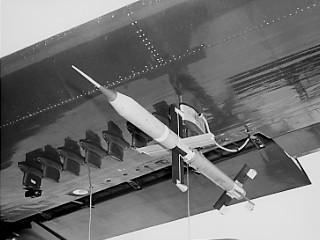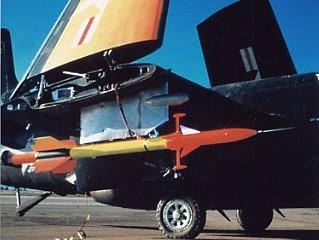Eastman Kodak ASM-N-6 Omar
When the Korean War began in 1950, the U.S. Navy faced the problem that it had no tactical air-to-ground standoff missiles to keep attack aircraft out of the range of enemy groundfire. One of the systems designed to change this was the ASM-N-6 Omar, development of which was begun by Eastman Kodak in 1951. The first XASM-N-6 prototypes were ready for testing later that year.
The XASM-N-6 was based on the standard 12.7 cm (5 in) HVAR (High Velocity Aircraft Rocket) unguided air-to-surface rocket, and employed a kind of optical beam-riding guidance system. The Omar was equipped with aft-looking light sensors, allowing it to ride along a beam of light which was projected in the direction of the target by the launching aircraft. I have no data about Omar's performance characteristics, but with its relatively small size and primitive guidance system, the range was probably less than about 8 km (5 miles).
 |
 | |
| Photos: U.S. Navy | ||
| XASM-N-6 | Sidewinder-Omar | |
Tests of the Omar continued until about 1954, when the program was cancelled because the guidance system apparently didn't work as planned. The XASM-N-6 used some components of the AAM-N-7/AIM-9 Sidewinder (servogenerator and roll-rate stabilizer), and it is possible that the test vehicles called Sidewinder-Omar were actually converted Sidewinder missiles used to test the Omar guidance system.
Specifications
I have no information about the exact physical characteristic of the XASM-N-6 missile.
Main Sources
[1] Norman Friedman: "US Naval Weapons", Conway Maritime Press, 1983
[2] Frederick I. Ordway III, Ronald C. Wakeford: "International Missile and Spacecraft Guide", McGraw-Hill, 1960
Back to Directory of U.S. Military Rockets and Missiles, Appendix 1
Last Updated: 22 January 2003